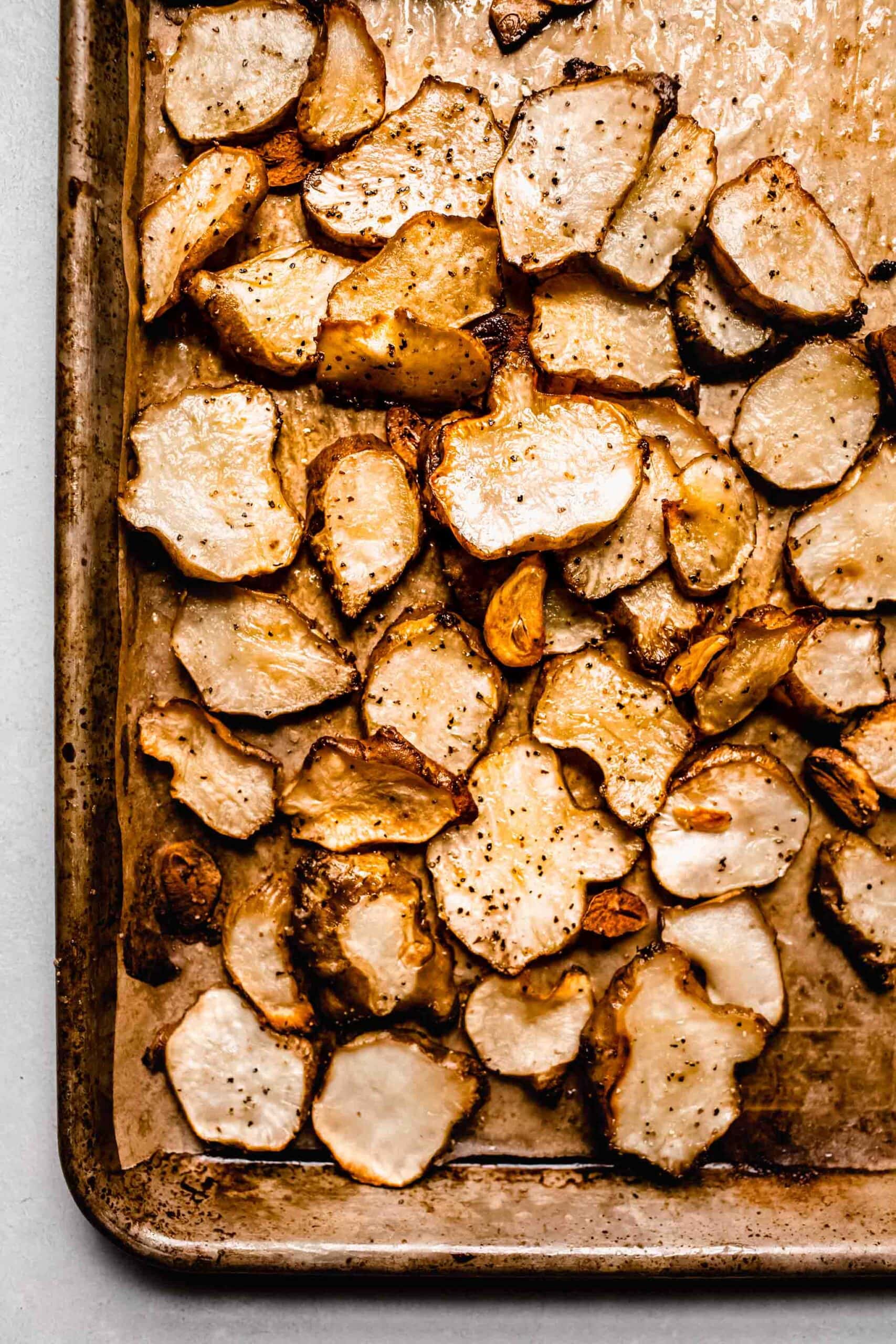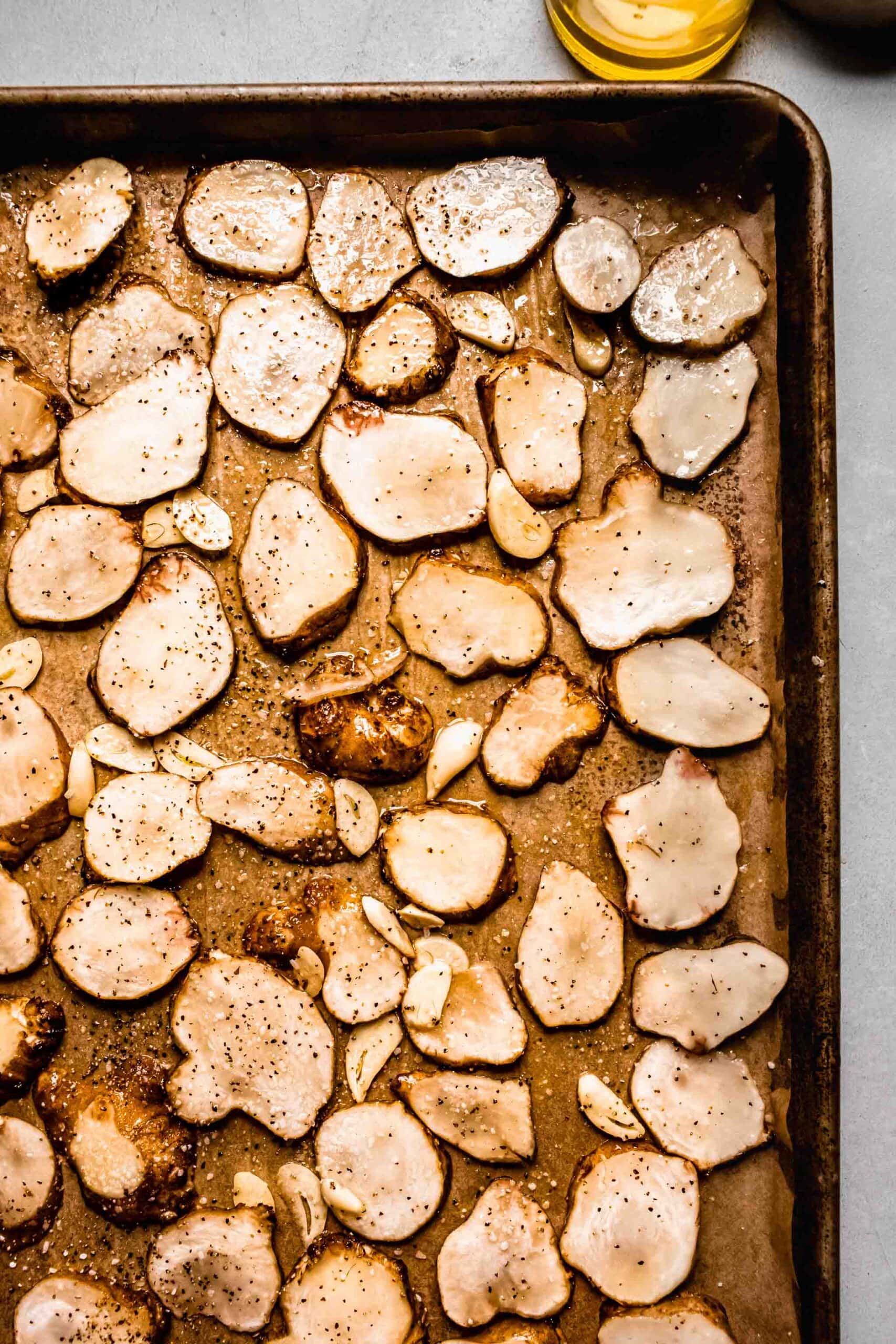Sunchokes are a knobby root vegetable that can be prepared in more ways than you can imagine! In this recipe, you’ll learn how to roast them with olive oil, garlic, and thyme. It’s an easy side dish you can pair with anything.
Have you noticed sunchokes popping up on menus, at farmer’s markets, or even at your everyday grocery store lately? The starchy root vegetable is growing in popularity because it not only tastes great but is as versatile as a potato. Add them to your grocery list if you haven’t already!
Sunchoke beginners will quickly fall in love with this roasted sunchokes recipe. The thin slices cook quickly in the oven and are seasoned with olive oil, garlic, and fresh thyme. Every bite is buttery and elegant. It’s the best side dish to serve next to Marinated Lamb Chops for special occasions or Air Fryer Chicken Breasts during busy weeknights.
Even though they’re a part of the sunflower plant family, just think of sunchokes as a substitute for carrots and potatoes. They can be mashed with butter, fried into chips, blended into a soup, and so much more!
These knobby, earthy root vegetables are part of the sunflower plant family. Also known as “Jerusalem artichokes” (despite not having roots in Jerusalem or being related to artichokes), they look like ginger roots on the outside but are closer in comparison to potatoes on the inside.
They grow underground, are in season from fall through spring, and can be prepared in almost any way you can imagine.
Like many root vegetables, sunchokes should be thoroughly washed and scrubbed with a vegetable brush before eating and cooking. A sunchoke’s skin is edible, so you don’t need to peel them, but sunchokes are often peeled prior to making dishes such as soups or purees to ensure a more uniform texture.

How do you cook sunchokes?
You can treat sunchokes just as you would any other root vegetable. They can be roasted, boiled, mashed, pickled, fried, grilled, or even eaten raw.
Roasting sunchokes is a great place to start for beginners. The sliced rounds are seasoned with simple herbs and aromatics to highlight their creamy, buttery flavor. Here’s how it’s done:
- Place the slices on a baking sheet and drizzle oil over top. Arrange them in a single layer and sprinkle with salt and pepper.
- Roast in the oven and add the sliced garlic cloves halfway through the cooking time. They’re ready when they’re golden brown and crispy.
- Toss the roasted sunchokes in the remaining oil. Season with thyme (or, try one of these thyme substitutes), salt, and pepper, then enjoy!

- Storing raw sunchokes: Wrap in paper towels and store them in a ziplock bag or an airtight container in the fridge. They should stay fresh for up to 10 days.
- Storing cooked sunchokes: This can depend on how you prepare them, but roasted sunchokes can be stored in an airtight container in the fridge for up to 5 days.
Sunchokes can be cooked with or without their skin. It’s up to you if you want to peel them!
Yes, they taste similar. Sunchokes are earthy and starchy like potatoes. And, once cooked, they have the same creamy texture as roasted potatoes.
Preparing sunchokes for roasting
- Wash them under cold water and scrub them well to remove dirt and debris from the skin.
- Sunchokes can be cooked with or without their skin. It’s up to you if you want to peel them!
- Slice them into thin rounds to prepare them for roasting.

How to Clean, Prepare and Cook Sunchokes
FAQ
Do sunchokes need to be peeled?
Do you need to peel Jerusalem artichokes?
Why do sunchokes make you gassy?
Do you peel Sunchokes before cooking?
Sunchokes are difficult to peel so cook them before you try to peel them. Peel them right after cooking because the skin will harden as it cooks. Place sliced or chopped sunchoke in acidulated water or the flesh will turn gray when it is exposed to air. Scrub the sunchokes and place them in cold water until ready to cook.
Can you eat the peel of an avocado?
Yes, you can eat the peel of an avocado. However, it is bitter and tough, so most people prefer to remove it. If you decide to eat the peel, make sure to wash the avocado first. You can search for avocado recipes or talk to a dietitian about ways to include avocado in your diet.
How do you know if Sunchokes are good?
When cooked, the flesh becomes almost buttery, creamy, and just a touch starchy. Look for firm, blemish-free sunchokes at farmers markets or grocery stores. Fall and winter are the peak harvest seasons if looking for local options. Avoid any with soft spots, visible mold, or wrinkled skin.
Should you leave skin on mashed Sunchokes?
Ordinarily it’s okay to leave the skin on if you’re roasting or frying, but for mashed sunchokes it’s better to remove it in order to achieve a smooth, creamy consistency. Place your hand on the back edge of the knife and use a “lever” motion to chop tough sunchokes more easily. Boil the sunchokes to soften them.
